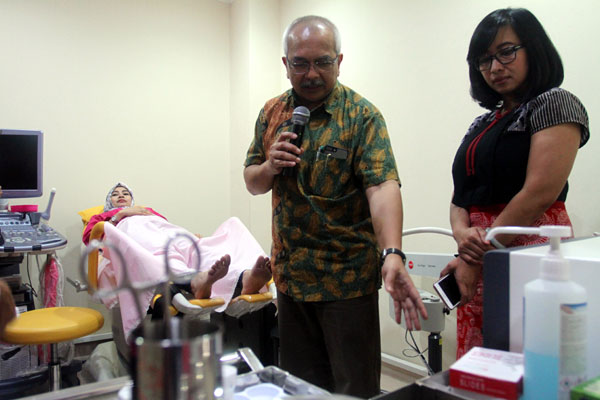Epidermal Growth Factor Receptor (EGFR) mutations in non-small cell lung cancer (KPKBSK) especially adenocarcinoma have played an important role in the last 10 years as a therapeutic target. The advanced-stage KPKBSK group with exon 18, exon 19 and exon 21 EGFR mutations responds much better when given targeted therapy in the form of a Tyrosine Kinase Inhibitor (TKI) compared to chemotherapy. It is indeed strongly supported by the availability of materials or samples and adequate examination tools, however, the examination of EGFR mutations is often hampered by the availability of tissue so that patients often miss the opportunity to get targeted therapy due to the unavailability of material for examination.
Lung cancer in Indonesia, is at top three of most cancers suffered, along with breast cancer and cervical cancer. Lung cancer is the cancer with the highest prevalence suffered by men. Based on data from the Dharmais Cancer Hospital in Jakarta, the prevalence of lung cancer from 2010 to 2013 always increased, where in 2010 there were 117 cases with 38 deaths, in 2011 there were 163 cases with 39 deaths, in 2012 there were 165 cases with 62 deaths, and in 2013 there were 173 cases with 65 deaths.
The incidence rate of pulmonary adenocarcinoma is increasing in Asia and the United States, especially in women, young and nonsmokers. Data in the United States showed pulmonary adenocarcinoma occurred in about 31% -54% of nonsmokers compared to 25% -33% of smokers and occurred in 49% -74% of nonsmokers compared to 33% -43% of women who smoke.
Examination of mutations can currently be done through liquid biopsy. One method currently being developed is the detection of EGFR mutations from blood plasma material. An IGNITE study in Asia Pacific and Russia related to the prevalence of EGFR mutations taken from tissue and blood samples has found that the concordance of suitability from the results of 2,581 patients of EGFR mutation examination between tissue and blood samples is 80.5% (sensitivity 46.5% and specificity 95.6%). These results were quite convincing with a specificity of 95.6%, examination of EGFR mutations from blood samples can be used as a screening of KPKBSK cases. For Indonesian national level, research like this has never been done before.
This research is a descriptive analytic study with a prospective cohort design based on the results of EGFR examination from histopathological samples and liquid biopsy at Pulmonology clinic, Dr. Soetomo Hospital from March 2018 to December 2018. Results of detected EGFR mutations from subsequent plasma samples were compared with results from anatomic histopathology so concordance could be obtained.
The total number of subjects who met the inclusion criteria was 124. The characteristics of the most patients were in age range 55-59 years, male, non-smoker, the highest stage of IVA with the most metastatic sites in the pleura. There is a correlation between the prevalence of EGFR with the status of never smoking and the age of the patient. The results of plasma ctDNA examination showed that 27.4% EGFR mutations dominated by common mutations, while wild type EGFR mutations were 72.6%. Histopathological EGFR mutation results were 47.6%, wild type results were 52.4%. The sensitivity of ctDNA to histopathology is 48.3%, specificity is 90.9%, PPV is 82.35% and NPV is 66.67% and the concordance rate is 70.97%.
Author: Laksmi Wulandari
Details of the research available at





